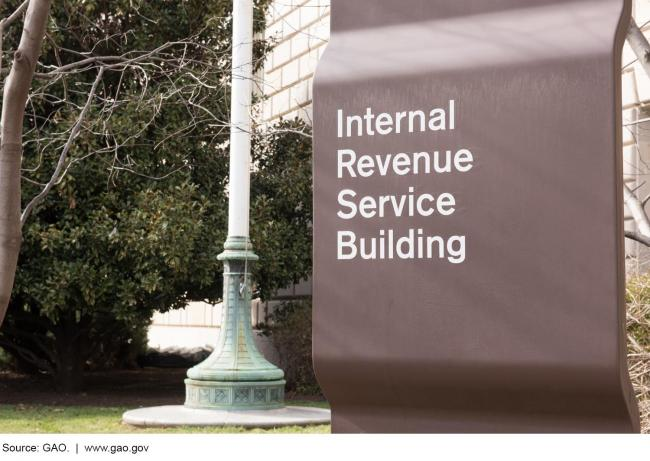Tax Administration: Status of IRS Future State Vision
Fast Facts
Facing declining budgets and aging information technology, in 2014 IRS officials began envisioning new approaches for interacting with taxpayers that they called the "Future State." They described the Future State as guiding principles—rather than a specific plan—to transform IRS.
This vision included giving taxpayers more web-based options for communicating with IRS and dealing with taxes. For example, a taxpayer might receive personalized messages and address tax problems via an online account at IRS.gov.
Although the IRS is phasing out the term "Future State," the effort's main themes are incorporated in IRS's new 5-year strategic plan.

Photo of IRS headquarters
Highlights
What GAO Found
In 2014, during a period of budget reductions and aging information technology systems at the Internal Revenue Service (IRS), IRS officials began discussing a new longer-term vision of tax administration that came to be known as the IRS Future State. This vision proposed a more interactive relationship between taxpayers and IRS to improve taxpayer service, enforcement, and operations. IRS launched this Future State vision to respond to external and internal factors that were requiring changes to its current taxpayer services and operations, such as the increasing complexity of the Federal tax system and evolving expectations of IRS services. To guide the vision, IRS narrowed 19 objectives from its Strategic Plan to a core set of objectives that it then used to develop six strategic themes, such as "facilitate voluntary compliance by empowering taxpayers with secure and innovative tools and support" and "drive more agility, efficiency, and effectiveness in IRS operations." IRS officials described the Future State as a set of guiding principles rather than a plan to transform the agency.
The ideas and concepts under the Future State vision are now being pursued as part of IRS's strategic plan for fiscal years 2018 to 2022--issued in May 2018--and IRS has been phasing out the use of the term Future State. The six strategic plan goals closely resemble the six Future State themes. IRS officials characterized this shift as more of a rebranding than a policy change because work that was part of the Future State vision will continue. IRS officials said it made sense to merge the Future State vision with the new strategic plan to create a single consistent IRS vision. In August 2018, IRS officials stated that they were preparing public communications about the transition from the Future State to the new strategic plan and its implementation.
Why GAO Did This Study
Funding the federal government depends largely upon the IRS's ability to collect taxes. This includes providing taxpayer services that make voluntary compliance easier, and enforcing tax laws to ensure compliance with tax responsibilities. For several years, GAO has recommended that IRS develop strategies to improve taxpayer services such as a long-term strategy for providing web-based services to taxpayers.
GAO was asked to describe the changes that IRS plans under the Future State. This report describes: (1) the Future State, its objectives and its history; and (2) the current status of the Future State. To answer these objectives, GAO reviewed IRS public and internal documents about the Future State, and interviewed relevant IRS officials.
For more information, contact James R. McTigue, Jr., at 202-512-9110 or McTigueJ@gao.gov.
